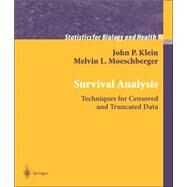- ISBN: 9780387953991 | 038795399X
- Cover: Hardcover
- Copyright: 2/1/2003
Applied statisticians in many fields frequently analyze time-to-event data. While the statistical tools presented in this book are applicable to data from medicine, biology, public health, epidemiology, engineering, economics and demography, the focus here is on applications of the techniques to biology and medicine. The analysis of survival experiments is complicated by issues of censoring and truncation. The use of counting process methodology has allowed for substantial advances in the statistical theory to account for censoring and truncation in survival experiments. This book makes these complex techniques accessible to applied researchers without the advanced mathematical background. The authors present the essentials of these techniques, as well as classical techniques not based on counting processes, and apply them to data. The second edition contains some new material as well as solutions to the odd-numbered revised exercises. New material consists of a discussion of summary statistics for competing risks probabilities in Chapter 2 and the estimation process for these probabilities in Chapter 4. A new section on tests of the equality of survival curves at a fixed point in time is added in Chapter 7. In Chapter 8 an expanded discussion is presented on how to code covariates and a new section on discretizing a continuous covariate is added. A new section on Lin and Ying's additive hazards regression model is presented in Chapter 10. We now proceed to a general discussion of the usefulness of this book incorporating the new material with that of the first edition.







